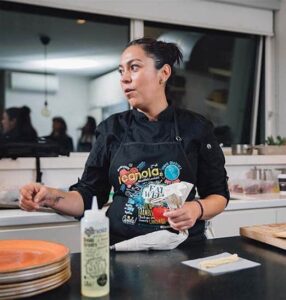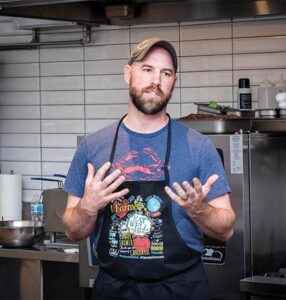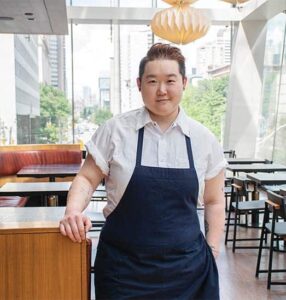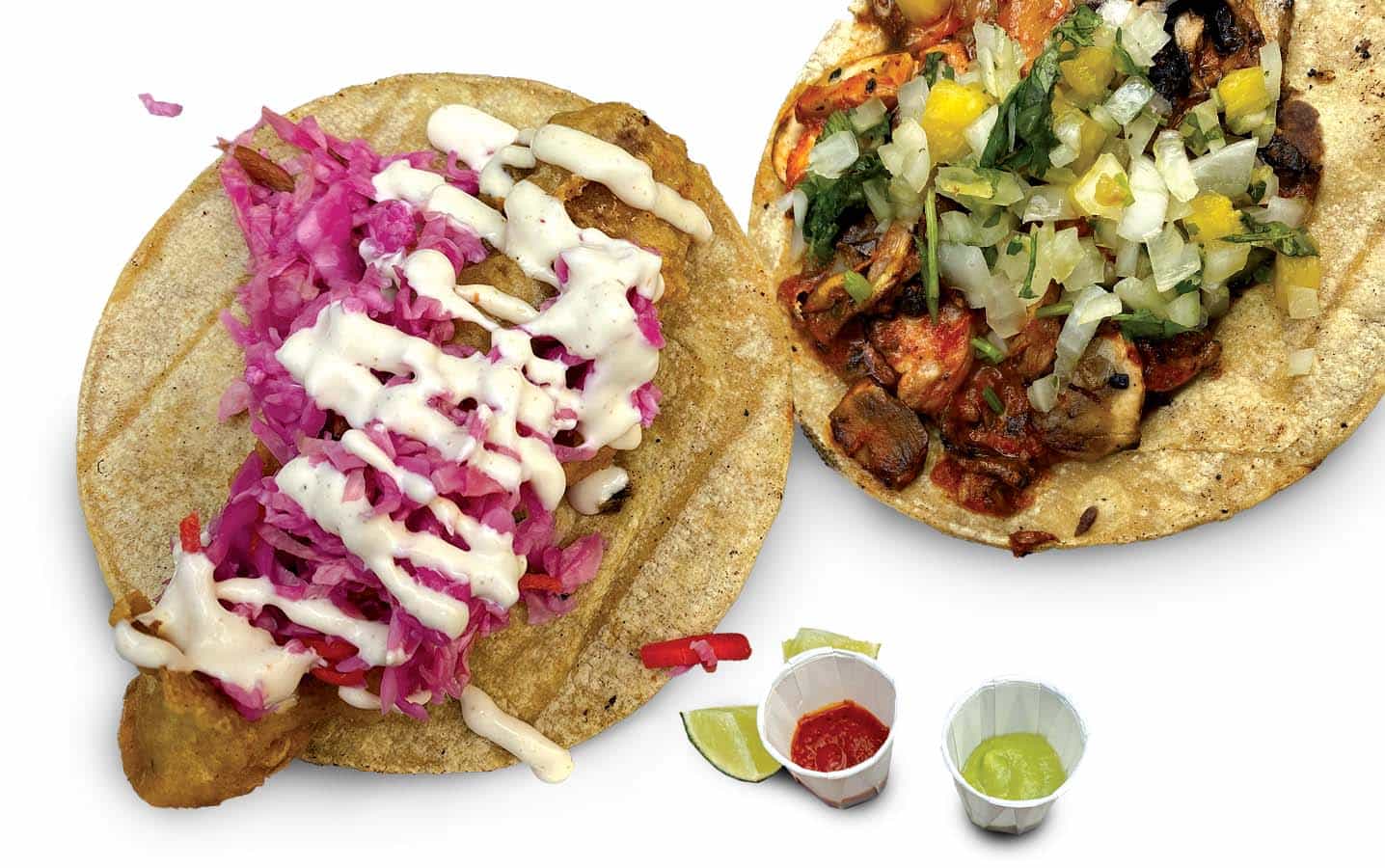Hey chefs, what are customers asking about your ingredients?
 Elia Herrera runs Colibri taqueria restaurant in Toronto and is the menu and theme consultant for a new restaurant, Tatemado, in Edmonton.
Elia Herrera runs Colibri taqueria restaurant in Toronto and is the menu and theme consultant for a new restaurant, Tatemado, in Edmonton.
“All the oil that I use is canola oil.”
—Elia Herrera
“All the oil that I use is canola oil,” Herrera says. She likes the high smoke point, which means the oil doesn’t burn at high frying temperatures. “This is healthier for us.” She also says the mild flavour of canola oil doesn’t change the flavour of her dishes.
Herrera grew up in the city of Veracruz, Mexico. Her grandmother was a chef, and she fried with canola oil and pork fat. So canola oil is a natural choice for Herrera in her Canadian restaurants.
When it comes to questions about her food, Herrera says, “I don’t get a lot of questions about the oil, but it is very important. People usually ask about the corn. Mexican cuisine is built around corn.”
Traditionally, Mexican cooks would prepare corn with alkaline to remove natural toxins and make the corn meal – called “mixtamal” – easier to digest. They used charcoal for centuries, then switched to lime. Herrera now uses calcium to get that same easy-to-digest texture that people expect in traditional Mexican corn tortillas. Colibri sources dry food-grade corn from Ontario.
The name Colibri is Spanish for hummingbird, and the word has deep spiritual roots for Mexicans. In Mayan language, colibri means messenger and for the Aztecs it also meant warrior.
“I’m a warrior,” Herrera says. “My grandmother taught me to be a strong, independent woman. She is my inspiration and, for her, I won’t give up.”
Herrera trained at the Culinary Institute of Mexico. While at a training stage in Spain, a friend from the Culinary Institute invited her to a class reunion in Toronto. She attended and decided to stay for a year. She has now been in Canada for 17 years. “I kept following the opportunities.”
Herrera connected with Canola Eat Well on a cooking demonstration in Toronto five years ago. She made tortilla soup and churros with a group of women, including food bloggers and dietitians.
 John Horne is executive chef with Oliver & Bonacini, overseeing nine locations, including Canoe and Auberge du Pommier restaurants in Toronto.
John Horne is executive chef with Oliver & Bonacini, overseeing nine locations, including Canoe and Auberge du Pommier restaurants in Toronto.
“I never had another issue with ingredients not being respected. And it made me realize the importance of showing staff and guests where their food comes from. You have to have those conversations to show what our amazing farmers are doing for us.”
—John Horne
Horne took part in a documentary called “Before the Plate,” which followed 10 ingredients back to the farms that produced them. The film caught the eye of Canola Eat Well staff. Horne attended the Canola Eat Well Harvest Camp in Manitoba in 2019 and has been the guest chef at Canola Eat Well learning workshops in Toronto. “The camp was amazing,” he says. “We travelled around meeting farms and learning about so many things – not just canola.”
The common customer question these days is about prices, Horne says. “Supply isn’t there to keep up with demand, and prices are going through the roof,” he says. Beef, for example, has doubled in price since the start of the pandemic. Horne has two approaches to make this work for the business. First, he has to keep high-end steaks on the menu, so customers simply have to pay the higher price. Second, he gets creative with cuts he doesn’t usually use – like flank, skirt and “coulotte” (top sirloin) steaks.
“Coulotte has great flavours,” he says, “but it has a big fat cap and can be tough.” One preparation Horne uses is to sear the coulotte, then slow poach it in flavoured canola oil.
“Margins in the restaurant business are always very tight, but now more than ever, we have to be creative to make a buck,” he says.
A big part of Horne’s job at O&B is to keep everyone inspired, keep up with or stay ahead of trends, and help chefs find the best ingredients.
“I use canola oil in every one of our restaurants and at home, and I did this before I made the connection with Canola Eat Well,” Horne says.
When Horne was chef at Canoe restaurant, a high-end Canadian-inspired restaurant, his goal was to make every dish as Canadian as possible. So he looked for a canola oil that would allow him to take olive oil off the menu. He found what he needed from Ontario farmer Jason Persall, who runs Pristine Gourmet, a maker of cold-pressed oils. “The colour of cold-pressed canola oil is outstanding,” Horne says. “We just went wildfire with that oil in our menus.”
One example was a soup made from artichokes and pork belly, and drizzled with cold-pressed canola oil. “The canola oil brought out different flavours in the soup, like a fine wine does for food,” he says. It inspired many conversations with customers. “I would go out into the restaurant and talk with tables about that dish and that oil,” he says.
Horne likes to make a connection with his guests, to talk about the food, and show respect for the ingredients. While chef at Canoe, he was “over the moon” when he found some Canadian-grown salad greens that were of the type and quality he used while a chef in France. “I put these salad greens all over the menu.” Then one day he found a tub of the greens wilting in the fridge, and it broke his heart.
“I blamed myself for letting that happen. So I rented a bus and rounded up 40 sous chefs, cooks and serving staff and we drove to the farm to see how the greens are grown,” he says. They spent three hours in the gardens, pulling weeds, picking greens and gaining an appreciation for the work involved in growing food.

 Chef Eva Chin just joined Avling, a “farm to table” restaurant in Toronto. The restaurant has a close connection to its ingredient supply chain, and prepares dishes with a mind to increase food security and reduce waste. Avling has a 100-square-foot garden on the roof, and everything from that garden ends up on the menu. They also butcher whole animals on site, using all parts in the menu. Anything compostable goes back into the roof-top garden.
Chef Eva Chin just joined Avling, a “farm to table” restaurant in Toronto. The restaurant has a close connection to its ingredient supply chain, and prepares dishes with a mind to increase food security and reduce waste. Avling has a 100-square-foot garden on the roof, and everything from that garden ends up on the menu. They also butcher whole animals on site, using all parts in the menu. Anything compostable goes back into the roof-top garden.
Chin uses canola oil in baking to reduce the amount of butter, and in emulsions like vinaigrettes and mayonnaise.
Chin was born and raised on her grandmother’s farm in Hawaii, and has Hawaiian, Singaporean and Chinese heritage. Chin advocates for Chinese cooking, and promotes the Chinese Restaurant Awards in B.C. That is how Canola Digest connected with Chin. Canola Eat Well sponsors a critics’ choice award for the Chinese Restaurant Awards, and Rae Kung, managing director of the awards, recommended Chin for this article. “Chef Eva Chin is our star chef ambassador in Canada,” Kung says.
“We need diversity in our diets, our crops and our land.”
—Eva Chin
But while these roots influence Chin’s cooking, Chin says a restaurant should go beyond its nationality.
“For too long, restaurant themes had to be geographic – Italian, Chinese, Scandinavian, etc,” Chin says. (Avling is a Norwegian word meaning “crop”.) Chin prefers restaurant themes that consider food security, reduced waste, local supply and diversity. “We need diversity in our diets, our crops and our land.”
Chin has regular conversations with restaurant guests, and remembers one recent question about cold-pressed canola oil. Chin likes to cook ceviche and crudo – dishes that combine raw seafood with an acid like vinegar or lime juice, along with flavourings like peppers and oils. A customer eating ceviche with drizzle of cold-pressed canola oil, which Chin likes for its “nutty, aromatic flavour”, was concerned that it was peanut oil. The person had a peanut allergy. Chin had to assure the person that the nutty-tasting oil was actually canola oil.

Chin also uses canola oil in baking to reduce the amount of butter, and in emulsions like vinaigrettes and mayonnaise.
Close connection to the ingredients is part of Chin’s community-minded approach to cooking. “I want to run a restaurant that people visit regularly, not just for special occasions. I want it to be part of the community.”





